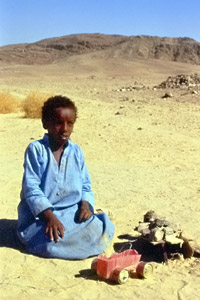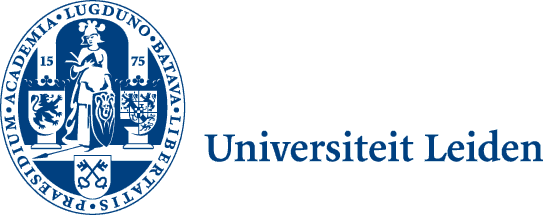Conference on "The Peoples of the Eastern Desert from the Prehistory to the Present"
The conference on "The Peoples of the Eastern Desert from the Prehistory to the Present" took place at the NVIC from 25 November till 27 November 2008. A meeting organized by The Cotsen Institute of Archaeology at UCLA and the Netherlands-Flemish Institute in Cairo.
- The Conference

- In 1998, the Netherlands-Flemish Institute in Cairo (NVIC) published the
proceedings of a meeting entitled “Life on the Fringe,” organized by
Olaf Kaper, now at Leiden University, and Willeke Wendrich, now at the
University of California, Los Angeles (UCLA). The subject of the meeting and
the volume was life in the desert areas of Egypt in Graeco-Roman times (332
BCE–641 CE). In 2008, the Cotsen Institute of Archaeology at UCLA published
the combined proceedings of two meetings, in Montreal and Los Angeles,
entitled “Nomads in Archaeology,” organized by Willeke Wendrich and
Hans Barnard, Research Associate with the Cotsen Institute. The subject of
these meetings and the volume was the archaeology of mobile peoples, with a
geographical emphasis on Central Asia and the desert zone between the Red Sea
and the Nile Valley in Egypt and Sudan. The mineral wealth of the latter area,
usually referred to as the Eastern Desert, has attracted miners and quarrymen
from very early times onward. Their remains and those of the various harbors
and trade routes that connected the Nile Valley with Arabia Felix, sub-Saharan
Africa, India and the enigmatic Land of Punt, have attracted most of the
attention of historians and archaeologists that study the region. Despite
environmental degradation, which started with the end of the Holocene pluvial
period or “wet phase,” ca. 8000 years ago, and scholarly neglect the
Eastern Desert has native inhabitants and a history of its own. The arrival in
the Nile Valley of the hunter-herder-gatherers is one of the many factors that
gave rise to Pharaonic civilization. Sometimes a hint of those that remained
behind can be gleaned from the historical sources, for instance in the case of
the Medjay (ca. 2250–1800 BCE) and the Blemmyes (ca. 600 BCE–600
CE), or in the archaeological record, such as pan-graves (ca. 1650–1500
BCE) and Eastern Desert Ware (ca. 300–600 CE), but information on the
indigenous history and culture remains scarce and incomplete.
-
.jpg)
- It is clear that the pastoral nomads in the Eastern Desert have always depended on the farmers in the Nile Valley, while the farmers needed the products of the desert dwellers in almost equal measure. Many economical, environmental and political factors determine whether groups will move or settle and a terminology with fixed categories for mobile and sedentary groups is no more applicable to the ancient situation than to the present. Much like the ancient names, such as Medjay or Blemmyes, do not correspond with our modern use of such ethnic terms, so does our understanding of words like tribe, nomad or Bedouin not correspond to reality. Apart from logistical problems, the study of the Eastern Desert is hampered by biases in the textual sources, by ambiguous ethnographic parallels and by the low archaeological visibility of the remains of the desert dwellers. The vast majority of the historical sources were written by outsiders who never visited the area. These were prejudiced towards a settled way of life and express negative attitudes, which exist until today, towards mobile groups. Ethnographic and ethno-archaeological information is limited and provides incomplete parallels between modern and ancient mobile groups. The emphasis of the archaeological research has been on the better visible and easier to interpret remains of the mines, quarries and trade routes of outsiders temporarily settling in the desert. Many studies concentrate on Pharaonic and Graeco-Roman Egypt, disregarding Nubian, Napatan and Meroitic sources of information.
-
.jpg)
- It has recently been appreciated that nomadic people are not archaeologically or historically invisible, but leave traces that are discernable and often specific for a nomadic way of life. A new interpretation of existing data will lead to new insights, while new archaeological tools and techniques will dramatically increase the number of sites and artifacts, as well as the information gleaned from them. During the past decades the anthropological theory on the relationship between the settled majority and the mobile minority in the Near East has developed from the permanent conflict reflected in many historical sources to the symbiotic relationship that can be deduced from archaeological and ethnographical data. Unfortunately, these insights come at a time that access into the Eastern Desert has become increasingly difficult. A conference aimed to address the problems and possibilities of the study of the dwellers of the Eastern Desert, as well as to provide an overview of the current state of our knowledge, took place at the NVIC on 25–27 November 2008. This meeting was organized by Hans Barnard and Kim Duistermaat, the current director of the NVIC, with the assistance of staff members of the NVIC and financial support of the Royal Netherlands Embassy in Cairo and the Cotsen Institute.
-
.jpg)
- The first two days of the conference were filled with short presentations covering a wide variety of subjects and time periods. The first session concentrated on the natural environment and the prehistory of the desert. A number of important sites with petroglyphs were presented and discussed, as well as the archaeology of some of the more ancient sites in the desert. The second session centered on current and future developments, both in the desert and in research strategies. It became evident that the area and its inhabitants have always been in flux and that, while certain aspects appear constant, there is no firm evidence for a true continuity in human activities or even human presence. On-going climate change and development of the region for tourism are now transforming the Eastern Desert at a rapid pace and demand inventive input concerning archaeological and environmental preservation. The second day there were sessions on the area in Graeco-Roman times, during which the Eastern Desert saw more visitors from outside than ever before, and on the traces of similar visitors during other periods, including the Coptic monks that still retreat into the desert where they inevitably compete with the native inhabitants for space, water and other resources. During the lively discussion that followed these sessions, as well as each individual presentation, it was concluded that the distinction between outsider and insider information was not as clear as initially assumed, while as much information as possible needs to be taken into account if we want to further our knowledge efficiently. A lot can still be learned from existing material and texts, much of which are unpublished, as well as the study of satellite imagery and reports and maps of the colonial period. Special attention needs to be given to the understanding of the archaeoclimate and to landscape archaeology, together with the development and testing of models for the movement of people.
-
.jpg)
- As it would not have been appropriate to discuss the history of a people so close to their homeland without any of them present, the morning of the third and last day of the conference was spend talking to representatives of several Bedouin tribes, from the Sinai and the Egyptian Red Sea coast. This part of the program was made possible by the logistical and linguistic assistance of Karin van Opstal, Rudolf de Jong and Amir Gohar. The Bedouin appeared well aware of the changing of their environment and life-style. All mentioned the push of the deteriorating desert, with its lack of possibilities for improvement, and the pull of the city, with its schools, jobs and televisions. At the same time, all were worried to loose their customs and traditions, which feature prominently in their oral history and personal identity. In the evening, the conference was summarized and its preliminary conclusions discussed by Dr. J.L. Bintliff, Professor of Classical Archaeology at Leiden University, during the yearly Cleveringa Lecture. This lecture is held in Leiden and many other places world-wide to commemorate the brave stance taken on 26 November 1940 by Dr. R.P. Cleveringa, at the time Professor of Law at Leiden University, when he denounced the firing of his colleague Dr. E.M. Meijers by the Nazi government only because of his Jewish upbringing. The Cleveringa Lecture in Cairo and the subsequent reception were well attended by men and women of many different backgrounds. The final proceedings of the conference on the history of the peoples of the Eastern Desert, together with contributions of invited authors, will be submitted and hopefully accepted for publication with the Cotsen Institute.
- All the information on the conference can be found:
http://www.archbase.org/ED
- Hans Barnard, Research Associate
Cotsen Institute of Archaeology at UCLA
P.O.Box 951510
Los Angeles, CA 90095
United States of America
fax: +1 (310) 206 4723
nomads@ucla.edu
Dr. Kim Duistermaat, Director
Netherlands-Flemish Institute in Cairo
1, Dr. Mahmoud Azmi Street
P.O.Box 50
11211 Zamalek, Cairo
Arab Republic of Egypt
http://nvic.leidenuniv.nl/
info@nvic.net.eg


